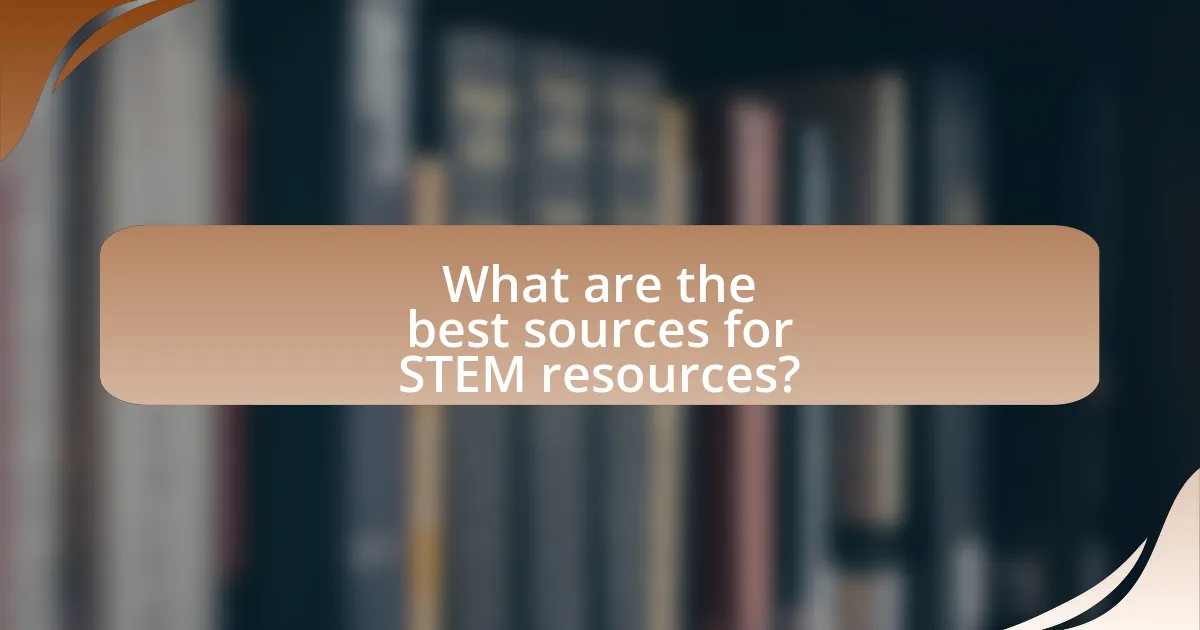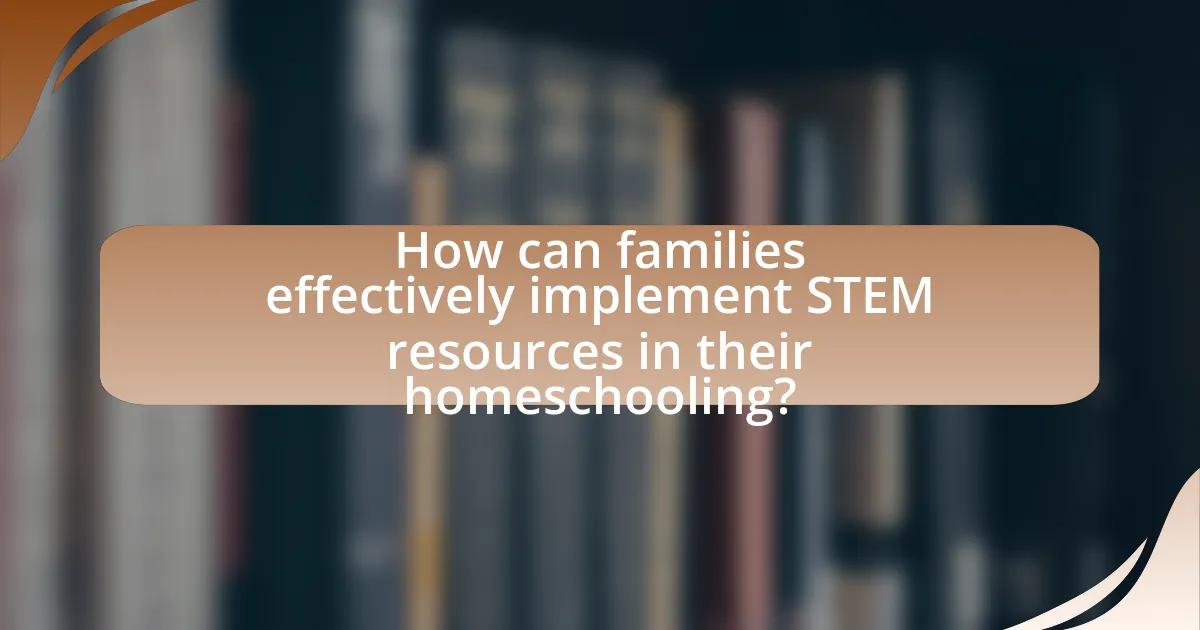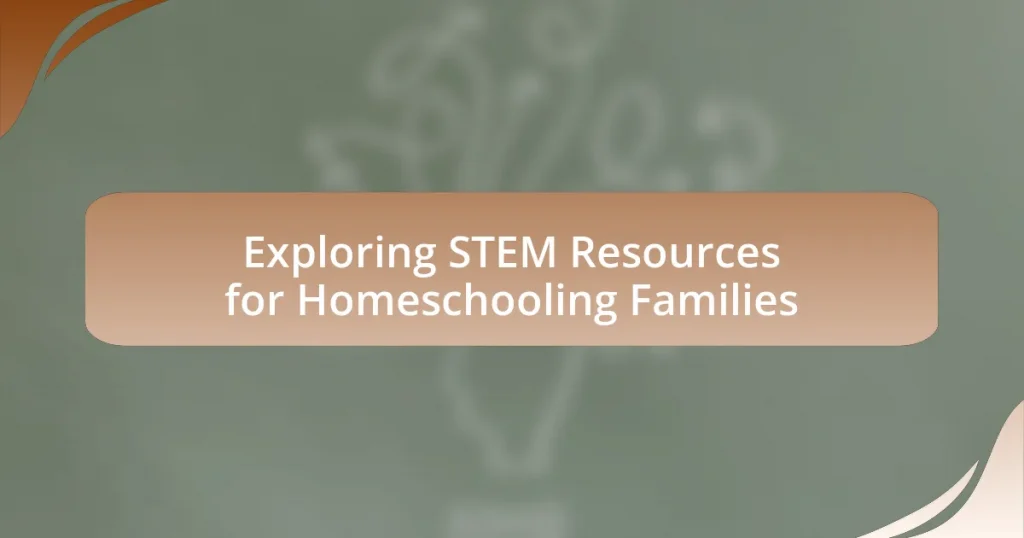The article focuses on STEM resources available for homeschooling families, highlighting various online platforms, educational kits, and community programs that enhance learning in science, technology, engineering, and mathematics. It discusses how these resources support homeschooling education by providing structured materials that foster critical thinking and problem-solving skills. The article also outlines the types of STEM resources accessible to families, the importance of STEM education for future career opportunities, and strategies for effectively implementing these resources in daily lessons. Additionally, it addresses potential challenges families may face and offers best practices for utilizing STEM resources to maximize educational outcomes.

What are STEM resources for homeschooling families?
STEM resources for homeschooling families include online platforms, educational kits, and community programs that facilitate learning in science, technology, engineering, and mathematics. Notable online platforms such as Khan Academy and Coursera offer free courses tailored for various age groups, providing structured learning paths in STEM subjects. Educational kits, like those from KiwiCo and Snap Circuits, deliver hands-on projects that engage students in practical applications of STEM concepts. Additionally, local community programs, such as science fairs and robotics clubs, offer opportunities for collaboration and real-world experience. These resources collectively support homeschooling families in delivering a comprehensive STEM education.
How do STEM resources support homeschooling education?
STEM resources support homeschooling education by providing structured, engaging materials that enhance learning in science, technology, engineering, and mathematics. These resources, such as online courses, interactive simulations, and hands-on experiments, facilitate a deeper understanding of complex concepts. For instance, a study by the National Home Education Research Institute found that homeschooled students often outperform their peers in standardized tests, particularly in STEM subjects, due to the tailored and resource-rich learning environments that homeschooling can offer. This evidence underscores the effectiveness of STEM resources in fostering academic success and interest in these critical fields.
What types of STEM resources are available for homeschooling families?
Homeschooling families have access to various types of STEM resources, including online courses, educational kits, interactive apps, and community programs. Online platforms like Khan Academy and Coursera offer structured courses in science, technology, engineering, and mathematics, allowing families to tailor learning to their child’s pace. Educational kits, such as those from KiwiCo or Snap Circuits, provide hands-on projects that engage students in practical applications of STEM concepts. Interactive apps, like Tynker for coding or Star Walk for astronomy, enhance learning through gamification and real-time exploration. Additionally, local community programs, such as science fairs or robotics clubs, offer opportunities for collaboration and real-world experience in STEM fields.
How can STEM resources enhance critical thinking skills in students?
STEM resources enhance critical thinking skills in students by providing hands-on, problem-based learning experiences that require analysis, evaluation, and synthesis of information. Engaging with STEM activities, such as experiments or coding projects, encourages students to ask questions, formulate hypotheses, and test their ideas, fostering a mindset geared towards inquiry and exploration. Research indicates that students who participate in STEM education demonstrate improved problem-solving abilities and higher-order thinking skills, as evidenced by studies showing that project-based learning in STEM contexts leads to significant gains in critical thinking assessments.
Why is STEM education important for homeschooling families?
STEM education is important for homeschooling families because it equips students with critical thinking, problem-solving, and analytical skills essential for success in a technology-driven world. Research indicates that students engaged in STEM learning perform better in mathematics and science, with a study from the National Math and Science Initiative showing that students who participate in STEM programs score 20% higher on standardized tests compared to their peers. Additionally, STEM education fosters creativity and innovation, preparing students for future careers in high-demand fields such as engineering and computer science.
What are the long-term benefits of STEM education for children?
The long-term benefits of STEM education for children include enhanced problem-solving skills, improved critical thinking abilities, and increased career opportunities in high-demand fields. Research indicates that students engaged in STEM education are more likely to pursue careers in science, technology, engineering, and mathematics, which are projected to grow significantly; for instance, the U.S. Bureau of Labor Statistics forecasts that employment in STEM occupations will grow by 8% from 2019 to 2029, faster than the average for all occupations. Additionally, STEM education fosters creativity and innovation, equipping children with the skills necessary to adapt to an ever-evolving job market.
How does STEM education prepare students for future careers?
STEM education prepares students for future careers by equipping them with critical thinking, problem-solving, and technical skills essential in the modern workforce. This educational approach emphasizes hands-on learning and real-world applications, fostering creativity and innovation. According to the U.S. Bureau of Labor Statistics, jobs in STEM fields are projected to grow by 8% from 2019 to 2029, significantly faster than the average for all occupations, highlighting the increasing demand for STEM skills in various industries. Furthermore, a study by the National Math and Science Initiative found that students engaged in STEM education are more likely to pursue degrees in STEM fields, leading to higher earning potential and job stability.

What are the best sources for STEM resources?
The best sources for STEM resources include educational websites, online platforms, and community organizations. Websites like Khan Academy and Coursera offer free courses and materials in various STEM fields, while platforms such as Edutopia provide articles and resources specifically tailored for educators and homeschooling families. Additionally, organizations like the National Science Teachers Association and the American Society for Engineering Education offer valuable resources, including lesson plans and teaching strategies, to support STEM education. These sources are recognized for their quality and accessibility, making them effective tools for enhancing STEM learning.
How can homeschooling families find quality STEM resources?
Homeschooling families can find quality STEM resources by utilizing online platforms, local libraries, and educational organizations. Online platforms such as Khan Academy and Coursera offer free courses and materials specifically designed for STEM education. Local libraries often provide access to STEM-related books, kits, and workshops, while educational organizations like the National Science Teachers Association offer curated resources and lesson plans. According to a report by the National Center for Education Statistics, 3.7 million students were homeschooled in the U.S. in 2020, highlighting the growing need for accessible and quality educational resources.
What online platforms offer STEM resources for homeschooling?
Online platforms that offer STEM resources for homeschooling include Khan Academy, which provides free courses in math and science, and National Geographic Kids, which offers interactive content related to science and geography. Additionally, platforms like Code.org focus on computer science education, while PBS LearningMedia provides a variety of STEM-related videos and lesson plans. These platforms are widely recognized for their educational quality and accessibility, making them valuable resources for homeschooling families.
Which local organizations provide STEM resources for families?
Local organizations that provide STEM resources for families include the Science Museum, local libraries, and community colleges. The Science Museum often offers workshops and hands-on activities designed for families to engage in STEM learning together. Libraries frequently host STEM-related events and provide access to educational materials and kits. Community colleges may offer classes or programs specifically aimed at families interested in enhancing their STEM education. These organizations are instrumental in promoting STEM education and providing accessible resources to families.
What criteria should families consider when selecting STEM resources?
Families should consider the educational value, age appropriateness, and alignment with learning objectives when selecting STEM resources. Educational value ensures that the resources effectively teach STEM concepts, while age appropriateness guarantees that the material is suitable for the child’s developmental stage. Alignment with learning objectives helps families choose resources that support specific educational goals, such as enhancing problem-solving skills or fostering creativity in science and technology. Research indicates that resources that meet these criteria significantly improve student engagement and learning outcomes in STEM subjects.
How do age appropriateness and learning styles affect resource selection?
Age appropriateness and learning styles significantly influence resource selection in homeschooling, particularly in STEM education. Resources must align with the developmental stages of learners to ensure engagement and comprehension; for instance, younger children benefit from hands-on activities that promote exploration, while older students may require more complex problem-solving tasks. Additionally, recognizing diverse learning styles—such as visual, auditory, and kinesthetic—enables educators to choose materials that cater to individual preferences, enhancing retention and understanding. Research indicates that tailored resources improve learning outcomes; a study by Pashler et al. (2008) highlights that matching instructional methods to learning styles can lead to better academic performance. Thus, age appropriateness and learning styles are critical factors in selecting effective educational resources for homeschooling families.
What role do reviews and recommendations play in choosing STEM resources?
Reviews and recommendations significantly influence the selection of STEM resources by providing insights into the effectiveness and quality of educational materials. Parents and educators often rely on feedback from other users to assess whether a resource meets their educational needs and aligns with curriculum standards. For instance, a study published in the Journal of Educational Psychology found that 85% of parents consider online reviews when choosing educational tools for their children, indicating that peer evaluations are a critical factor in decision-making. This reliance on reviews helps ensure that families select resources that have been tested and validated by others, ultimately enhancing the learning experience in STEM subjects.

How can families effectively implement STEM resources in their homeschooling?
Families can effectively implement STEM resources in their homeschooling by integrating hands-on activities, utilizing online platforms, and incorporating real-world applications. Hands-on activities, such as building simple machines or conducting science experiments, engage students and reinforce concepts through practical experience. Online platforms like Khan Academy and Code.org provide structured lessons and interactive exercises that cater to various learning styles. Additionally, applying STEM concepts to everyday life, such as cooking to teach measurements or gardening to explore biology, helps students see the relevance of STEM in their daily activities. Research indicates that experiential learning significantly enhances understanding and retention of STEM subjects, making these methods particularly effective for homeschooling families.
What strategies can be used to integrate STEM resources into daily lessons?
To integrate STEM resources into daily lessons, educators can employ project-based learning, where students engage in hands-on projects that require the application of science, technology, engineering, and mathematics concepts. This approach fosters critical thinking and problem-solving skills, as evidenced by a study from the University of Michigan, which found that students involved in project-based learning demonstrated higher engagement and retention of STEM knowledge compared to traditional methods. Additionally, incorporating technology tools, such as simulations and coding platforms, can enhance interactive learning experiences, making abstract concepts more tangible. By utilizing these strategies, educators can effectively weave STEM resources into everyday learning, promoting a deeper understanding of the subject matter.
How can project-based learning enhance the use of STEM resources?
Project-based learning enhances the use of STEM resources by providing hands-on, real-world applications that engage students in critical thinking and problem-solving. This approach allows learners to actively explore and utilize STEM resources, such as technology, engineering tools, and scientific methods, in the context of meaningful projects. Research indicates that students involved in project-based learning demonstrate higher retention of knowledge and improved collaboration skills, as evidenced by a study from the Buck Institute for Education, which found that 80% of students reported increased motivation and engagement in STEM subjects when participating in project-based activities.
What are some effective ways to assess student understanding of STEM concepts?
Effective ways to assess student understanding of STEM concepts include formative assessments, project-based learning, and standardized tests. Formative assessments, such as quizzes and interactive discussions, provide immediate feedback and help educators gauge student comprehension in real-time. Project-based learning allows students to apply STEM concepts in practical scenarios, demonstrating their understanding through hands-on activities. Standardized tests, while less flexible, offer a benchmark for evaluating student performance against established criteria. Research shows that combining these methods enhances overall assessment accuracy, as indicated by studies from the National Science Foundation, which highlight the importance of diverse assessment strategies in STEM education.
What challenges might families face when using STEM resources?
Families may face several challenges when using STEM resources, including accessibility, cost, and varying levels of expertise among family members. Accessibility issues arise when families lack reliable internet access or the necessary technology to utilize online STEM resources effectively. Cost can be a significant barrier, as many high-quality STEM materials and kits can be expensive, limiting options for families on a budget. Additionally, varying levels of expertise can create difficulties; parents may feel unqualified to teach complex STEM concepts, leading to frustration and disengagement. These challenges can hinder the effective use of STEM resources in a homeschooling environment.
How can families overcome common obstacles in STEM education?
Families can overcome common obstacles in STEM education by actively engaging in hands-on learning experiences and utilizing available resources. For instance, families can create a STEM-rich environment at home by incorporating everyday materials for experiments, which fosters curiosity and problem-solving skills. Research indicates that children learn effectively through experiential learning; a study by the National Science Foundation found that hands-on activities significantly enhance understanding of scientific concepts. Additionally, families can access online platforms and community resources, such as local science museums or educational websites, to supplement their learning. By leveraging these strategies, families can effectively navigate challenges in STEM education.
What support systems are available for homeschooling families using STEM resources?
Homeschooling families using STEM resources can access various support systems, including online communities, local co-ops, and educational platforms. Online communities, such as forums and social media groups, provide a space for parents to share resources, experiences, and advice, fostering collaboration and support. Local co-ops often offer group classes and activities focused on STEM subjects, allowing families to engage in hands-on learning experiences together. Educational platforms like Khan Academy and Coursera provide structured courses and materials specifically designed for STEM education, enabling families to supplement their homeschooling curriculum effectively. These support systems enhance the homeschooling experience by providing resources, social interaction, and structured learning opportunities tailored to STEM education.
What are some best practices for utilizing STEM resources in homeschooling?
To effectively utilize STEM resources in homeschooling, families should integrate hands-on activities, leverage online platforms, and encourage collaborative projects. Hands-on activities, such as experiments and building projects, enhance engagement and understanding of scientific concepts. Online platforms like Khan Academy and Coursera provide structured courses and resources that cater to various learning styles. Collaborative projects, whether with peers or family members, foster teamwork and problem-solving skills, essential components of STEM education. Research indicates that active learning strategies, including these practices, significantly improve student outcomes in STEM subjects, as shown in studies by the National Science Foundation.










